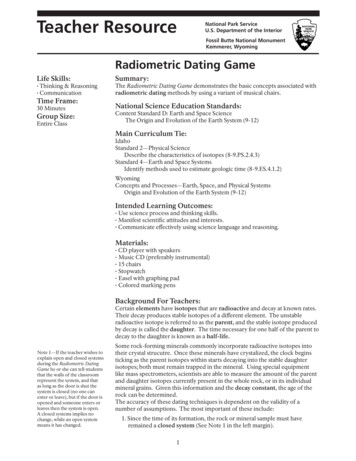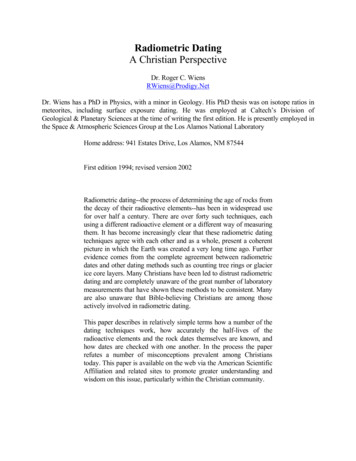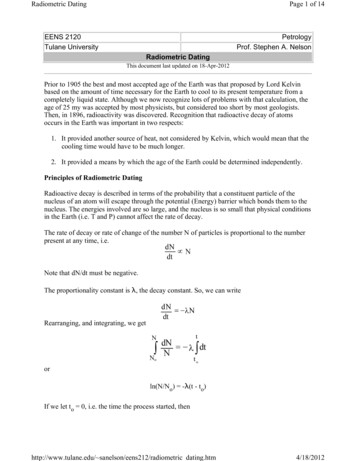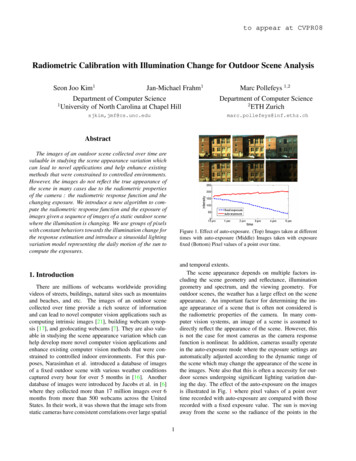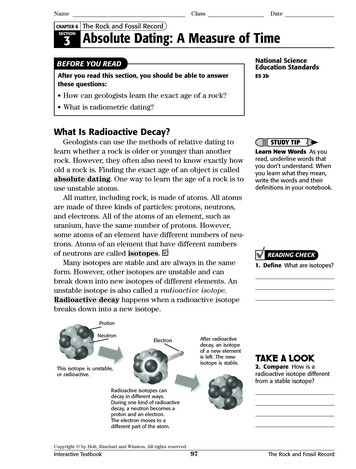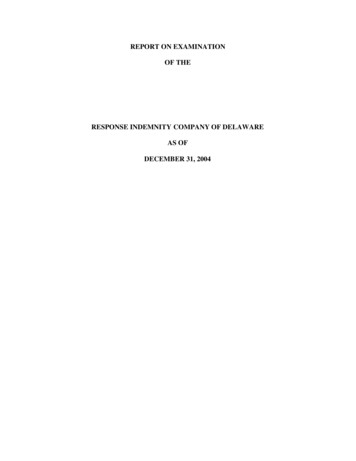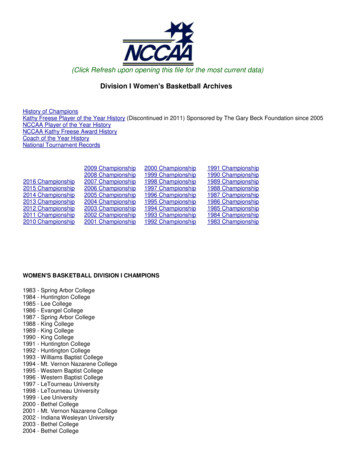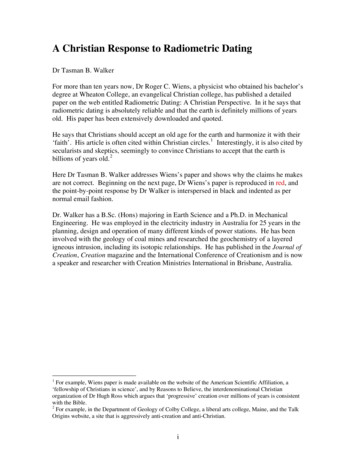
Transcription
A Christian Response to Radiometric DatingDr Tasman B. WalkerFor more than ten years now, Dr Roger C. Wiens, a physicist who obtained his bachelor’sdegree at Wheaton College, an evangelical Christian college, has published a detailedpaper on the web entitled Radiometric Dating: A Christian Perspective. In it he says thatradiometric dating is absolutely reliable and that the earth is definitely millions of yearsold. His paper has been extensively downloaded and quoted.He says that Christians should accept an old age for the earth and harmonize it with their‘faith’. His article is often cited within Christian circles. 1 Interestingly, it is also cited bysecularists and skeptics, seemingly to convince Christians to accept that the earth isbillions of years old. 2Here Dr Tasman B. Walker addresses Wiens’s paper and shows why the claims he makesare not correct. Beginning on the next page, Dr Wiens’s paper is reproduced in red, andthe point-by-point response by Dr Walker is interspersed in black and indented as pernormal email fashion.Dr. Walker has a B.Sc. (Hons) majoring in Earth Science and a Ph.D. in MechanicalEngineering. He was employed in the electricity industry in Australia for 25 years in theplanning, design and operation of many different kinds of power stations. He has beeninvolved with the geology of coal mines and researched the geochemistry of a layeredigneous intrusion, including its isotopic relationships. He has published in the Journal ofCreation, Creation magazine and the International Conference of Creationism and is nowa speaker and researcher with Creation Ministries International in Brisbane, Australia.1For example, Wiens paper is made available on the website of the American Scientific Affiliation, a‘fellowship of Christians in science’, and by Reasons to Believe, the interdenominational Christianorganization of Dr Hugh Ross which argues that ‘progressive’ creation over millions of years is consistentwith the Bible.2For example, in the Department of Geology of Colby College, a liberal arts college, Maine, and the TalkOrigins website, a site that is aggressively anti-creation and anti-Christian.i
Radiometric DatingA Christian PerspectiveDr. Roger C. WiensDr. Wiens has a PhD in Physics, with a minor in Geology. His PhD thesis was on isotoperatios in meteorites, including surface exposure dating. He was employed at Caltech’sDivision of Geological & Planetary Sciences at the time of writing the first edition. He ispresently employed in the Space & Atmospheric Sciences Group at the Los AlamosNational Laboratory.The subtitle ‘A Christian Perspective’ makes it clear that this paper is intended forChristians. The paper aims to persuade them that the world is billions of years old,contrary to the plain teaching of Scripture. Someone cheekily said a moreappropriate subtitle would be, ‘A Pseudo-Christian Uniformitarian Propagandasheet’. Although Wiens appears to have impressive credentials we must check allclaims (including mine) against the Scriptures: ‘test everything’ (1 Thessalonians5:21). Like the Bereans, who ‘examined the Scriptures every day to see if whatPaul said was true’ (Acts 17:11), the authority for the Christian is the Word ofGod, because we know that His word is true.Home address: 941 Estates Drive, Los Alamos, NM 87544First edition 1994; revised version 2002Unfortunately this paper does not address the results of the groundbreakingRadioisotopes and the Age of the Earth (RATE) creationist research initiative,published in 2005. 3Radiometric dating--the process of determining the age of rocks from the decay of theirradioactive elements--has been in widespread use for over half a century. There are overforty such techniques, each using a different radioactive element or a different way ofmeasuring them.That a method has a long history, is popular, and gives a consistent story is noguarantee that it is true. Similar claims were made for spontaneous generationand phlogiston.It has become increasingly clear that these radiometric dating techniques agree with eachother and as a whole, present a coherent picture in which the Earth was created a verylong time ago.3Vardiman, L. et al. (Eds.), Radioisotopes and the Age of the Earth Vol. II, ICR, El Cajon, CA,CRS, Chino Valley, AZ, 2005; and DeYoung, D., Thousands Not Billions, Master Books,Green Forest, AR, 2005.ii
That is, millions of years ago. But it is clear from Scripture that God created theearth by His word in six-days about 6,000 years ago. Which is true? Like manyChristians today, Wiens accepts that the earth is billions of years old, but in thisarticle he does not discuss the problems that idea creates for the integrity of theBible.There have been many attempts by many people to reinterpret the Scriptures toincorporate eons of time into the Bible, but no method works (which is why thereare so many). Every compromise position undermines the authority of Scriptureand damages the biblical world view. Like a blow to the heart, millions of yearsdestroy the Gospel by placing the fossil record, with its death and suffering,before sin entered the world through Adam and Eve. Thus, the issue is crucial forthe Christian (indeed for all people, because the Bible is true and its message hasconsequences for everyone).Further evidence comes from the complete agreement between radiometric dates andother dating methods such as counting tree rings or glacier ice core layers.The methods are made to agree because they are calibrated and compared witheach other.Many Christians have been led to distrust radiometric dating and are completely unawareof the great number of laboratory measurements that have shown these methods to beconsistent.Actually, the RATE research, which Wiens has not mentioned, shows themethods are consistently inconsistent. The most reliable technique (‘mineralisochrons’) applied in a single rock sample to four different sets of radioactiveelements and their daughters gives four quite different dates. Being from a singlerock, all the dates should be the same. But the dates differ by far more than themeasurement error, in several cases by up to a factor of two or three. Furthermore,the pattern of differences is consistently inconsistent. For example, beta-decayingelements (emitting an electron) always give lower ‘ages’ than alpha-decaying(emitting a helium nucleus) elements. 4 So the claim of ‘consistency’ is notcorrect.Many are also unaware that Bible-believing Christians are among those actively involvedin radiometric dating.Any Christian who considers that the Bible is reliable would distrust claims ofmillions of years. Even if we do not understand the science, our confidence in the4Snelling, A.A., Isochron discordances and the role of inheritance and mixing if radioisotopes inthe mantle and crust; in: Vardiman, L. et al. (Eds.), Radioisotopes and the Age of the Earth Vol. II,ICR, El Cajon, CA, CRS, Chino Valley, AZ, pp. 393–524, 2005. See also Snelling, A.A.,Radioisotope dating of rocks in the Grand Canyon, Creation 27(3):44–49, 2005.iii
Word would make us realize that something is wrong. So, if another Christianwho worked in the area said ‘Trust me’, we should still be uneasy about acceptingideas that so plainly contradict Scripture.This paper describes in relatively simple terms how a number of the dating techniqueswork, how accurately the half-lives of the radioactive elements and the rock datesthemselves are known, and how dates are checked with one another.He does describe the methods simply, but he does not explain the effects of theassumptions behind the methods, or how the results are handled in practice. In anutshell: it is impossible to make scientific measurements in the past; thus none ofthe methods measure age; every date is based on assumptions about the past;radioactive dating is not the primary method that geologists use to determine theage of a rock; all radioactive dates are interpreted to harmonize with thegeological interpretations from the field.In the process the paper refutes a number of misconceptions prevalent among Christianstoday. This paper is available on the web via the American Scientific Affiliation andrelated sites to promote greater understanding and wisdom on this issue, particularlywithin the Christian community.Although the paper is published on the website of ASA, an association ofChristian scientists, we should not accept claims that contradict the Bible.Especially we need to be aware that ASA is committed to interpreting scientificdata in terms of a billion-year-old earth.iv
Radiometric DatingA Christian PerspectiveDr. Roger C. WiensTABLE OF CONTENTSIntroduction. [1]Overview. [5]The Radiometric Clocks. [8]Examples of Dating Methods for Igneous Rocks . [10]Potassium-Argon . [12]Argon-Argon. [15]Rubidium-Strontium. [19]Samarium-Neodymium, Lutetium-Hafnium, and Rhenium-Osmium. [24]Uranium-Lead. [25]The Age of the Earth . [26]Extinct Radionuclides: The Hourglasses that Ran Out . [30]Cosmogenic Radionuclides: Carbon-14, Beryllium-10, Chlorine-36 .[33]Radiometric Dating of Geologically Young Samples . [37]Non-Radiogenic Dating Methods for the Past 100,000 Years. [40]Ice Cores. [40]Varves . [42]Other Annual-Layering Methods. [43]Thermoluminescence. [43]Electron Spin Resonance. [44]Cosmic Ray Exposure Dating. [44]Can We Really Believe the Dating Systems? . [45]Doubters Still Try. [48]Apparent Age? . [50]Rightly Handling the Word of Truth. [51]Appendix: Common Misconceptions Regarding Radiometric Dating Technique . [54]Resources on the Web. [63]Further Reading: Books . [63]Acknowledgements . [na]More About the Author.[na]Glossary . [na]v
IntroductionArguments over the age of the Earth have sometimes been divisive for people who regardthe Bible as God’s word.Division is nothing new for the Christian church because always there have beenpeople who seek to teach ideas that are contrary to sound doctrine. Paul warnedagainst those who teach ‘contrary to the teaching you have learned’ (Romans16:17). Jude made it clear that division in the church is caused by those who scoffat God’s word. Peter says the scoffers deliberately forget Creation and the Flood(2 Peter 3:3–7). Wiens’s associate Hugh Ross teaches an outwardly naturalistic‘creation’ and denies that the Genesis Flood was world-wide.So the issue is not ‘division’ but who is teaching sound doctrine. Wiens implieshere that those who insist on a young earth are being divisive, but it is the youngearth creationists who take Creation and the Flood seriously. Nowhere in hispaper does Wiens discuss what the Bible says about the age of the earth, yet hecalls this view a Christian view. For a Christian the Scripture is our highestauthority and our source of unity. In fact all people need to take heed of theScriptures because they speak the truth.Even though the Earth's age is never mentioned in the Bible, it is an issue because thosewho take a strictly literal view of the early chapters of Genesis can calculate anapproximate date for the creation by adding up the life-spans of the people mentioned inthe genealogies. Assuming a strictly literal interpretation of the week of creation, even ifsome of the generations were left out of the genealogies, the Earth would be less than tenthousand years old.True, the age of the earth is not mentioned specifically in the Bible, but that doesnot mean we cannot confidently determine the earth’s age from Scripture, or thatit is an unimportant issue. The Bible does not specifically mention the Trinity,Original Sin or the Virginal Conception but no one would suggest these doctrinesare not clearly set out in Scripture, or that they are unimportant.Notice where he lays the blame: ‘those who take a strictly literal view of the earlychapters of Genesis’. In other words, if the literalists would interpret Genesisdifferently the divisions would pass.But the age of the earth is logically deduced from the Bible, as Wiensacknowledges. Biblical literalists have not invented a new interpretation of theBible. The young-earth position has been the orthodox position for Christians for1,800 years. It is the long-age interpretation of Scripture that represents adeparture from orthodoxy.The secular writer Jack Repcheck in his biography of James Hutton, the Scottishgeologist who invented geological time, recognized this: ‘The Scottish1
Presbyterian Church, the English Anglican Church, the Lutheran Church and theCatholic Church—indeed, all Christian churches, their clergies, and theirfollowers—believed that the earth was not even 6,000 years old. This belief wasa tenet based on rigorous analysis of the Bible and other holy scriptures. It wasnot just the devout who embraced this belief; most men of science agreed that theearth was young.’ 5It was only with the rise of uniformitarian geology in the late 1700s, promoted,not primarily by Christians but by Bible rejecting deists, that this became an issuein the church. Note too that the long age for the earth did not arise with theadvent of radiometric dating but with Hutton’s new geologic philosophy.Radiometric dating was not invented until 100 years later, and it has beendeveloped in a way that it supports the uniformitarian philosophy.Radiometric dating techniques indicate that the Earth is thousands of times older thanthat--approximately four and a half billion years old.There we have it. A literal reading of the Bible yields an age for the earth ofaround 6,000 years (Wiens says less than 10,000, but that is a rounded number)whereas radioactive dating says the earth is 4.5 billion years old. That is why theage of the earth is important. If we can’t literally accept what the Bible says aboutthe age of the earth, then why should we literally accept what the Bible says aboutanything? No wonder the age of the earth is such an issue for those who opposeChristian values in the West. And Wiens wants Christians to concede the issuewithout any resistance.Many Christians accept this and interpret the Genesis account in less scientifically literalways.‘Everyone is doing it’ is no justification for Christians accepting any unbiblicaldoctrine, including the biblical age for the earth. We need to have biblical reasons.If we can accept Genesis, which is so plainly historical narrative, as ‘lessscientifically literal’, then where do we stop? If we say that Bible believingChristians can accept that 4,500,000,000 years is consistent with the biblical 6,000years then why should we be rigid about those passages which speak againsthomosexual behaviour, or adultery, or polygamy, or immorality, or lying, ormurder?However, some Christians suggest that the geologic dating techniques are unreliable, thatthey are wrongly interpreted, or that they are confusing at best. Unfortunately, much ofthe literature available to Christians has been either inaccurate or difficult to understand,so that confusion over dating techniques continues.5Repcheck, J., The Man Who Found Time: James Hutton and the Discovery of the Earth’sAntiquity, Perseus Publishing, Cambridge, MA, p. 14, 2003.2
When it comes to literature that explains how radioactive dating works and howreliable it is, Christians have access to the same material as the rest of thecommunity, including encyclopedias, museum exhibits, media articles, televisiondocumentaries and school text books. What Wiens is referring to here is theliterature written specifically for Christians explaining why we do not have tobelieve the ages that are quoted for radioactive methods and how they are basedon unprovable assumptions. Christians naturally are interested in such literaturebecause they can plainly see that the long ages contradict the Bible.The next few pages cover a broad overview of radiometric dating techniques, show a fewexamples, and discuss the degree to which the various dating systems agree with eachother. The goal is to promote greater understanding on this issue, particularly for theChristian community.Wiens says he wants to ‘promote greater understanding on this issue, particularlyfor the Christian community,’ but it seems his goal is rather to promote the longage position. He does not discuss the pros and cons of radiometric dating but onlypresents material that could overwhelm with science. Some of the informationprovided, though, is incorrect, and he does not explain how dates are interpretedin a way that makes it impossible to falsify the dating technique.Many people have been led to be skeptical of dating without knowing much about it.Sometimes we don’t need to understand everything about an issue before werealize it has problems. The Bible presents the truth, so if we have a goodknowledge of the biblical worldview we will have powerful insights into any newphilosophies or teachings we encounter, and realize when something is wrong.Psalm 119:99 says we will have more insight than our teachers when we meditateon God’s word.For example, most people don't realize that carbon dating is only rarely used on rocks.Correct, many people don’t realize this. But many people don’t realize either thatcarbon-14 provides powerful evidence for a young earth. He does not mentionthis. For example, in the RATE results that Wiens ignores, carbon-14 has beenfound in diamonds that were supposedly more than a billion years old, indicatingthat they can only be thousands of years old. 6 And every time carbon-14 datinghas been applied to rocks that do contain carbon, such as limestone, the resultingages are always thousands of years, not the hundreds of millions obtained byother radioactivity dating techniques on the same rocks. These glaring, thousandfold, differences are hugely outside the possible measurement errors of thedifferent techniques. So again, Wiens’s claim of ‘consistency’ runs aground onthe facts.6Sarfati, J., Diamonds: a creationist’s best friend, Creation 28(4):26–27, 2006; www.creationontheweb.com/content/view/4650 .3
God has called us to be "wise as serpents" (Matt. 10:16) even in this scientific age.Yes, especially when confronted with new ideas. As the Bible says, we need tobe alert for those who distort the truth: ‘Even from your own number men willarise and distort the truth in order to draw away disciples after them’ (Acts 20:30).In spite of this, differences still occur within the church. A disagreement over the age ofthe Earth is relatively minor in the whole scope of Christianity;If the age of the earth is such a minor issue, why has Wiens written such a longpaper on the topic? Why is the age such a focus of attacks from anti-Christianwebsites?it is more important to agree on the Rock of Ages than on the age of rocks. But becauseGod has also called us to wisdom, this issue is worthy of study.The fact is that the age of the earth is crucial to the integrity of the Christianworldview. Once we accept long ages the biblical picture of the Rock of Agesunravels. The Bible says that God created a good world, but if the world ismillions of years old then the fossils would mean that God created a world usingdisease, bloodshed and suffering. The Bible says that death is the consequence ofmankind’s sin, but if the world is millions of years old then death was here longbefore man sinned and has nothing to do with sin. The age of the earth isfoundational to the Christian worldview.OverviewHere begins a long and detailed tutorial. Don’t be awed into trusting radioactivitydating without question by the length and detail of this description. Nothing ofwhat is outlined here is a surprise to creationscientists who have studied these techniquesfor years. Most important, Wiens neglects topoint out the weaknesses of the methods.Rocks are made up of many individual crystals, andeach crystal is usually made up of at least severaldifferent chemical elements such as iron, magnesium,silicon, etc. Most of the elements in nature are stableand do not change. However, some elements are notcompletely stable in their natural state. Some of theatoms eventually change from one element to anotherby a process called radioactive decay. If there are a lotof atoms of the original element, called the parentelement, the atoms decay to another element, calledthe daughter element, at a predictable rate. Thepassage of time can be charted by the reduction in the4
number of parent atoms, and the increase in the number of daughter atoms.The word ‘charted’ is misleading. I’ve worked in power stations and they havecharts that continually record the temperatures and pressures of the turbines. Byinspecting these long charts we could see what happened to the machines in thepast. The use of the word ‘chart’ here is inappropriate because there is norecording of how the isotopes changed in a rock in the past. All we have is ameasurement of the isotopes in the rock at one point in time—the present.Radiometric dating can be compared to an hourglass. When the glass is turned over, sandruns from the top to the bottom. Radioactive atoms are like individual grains of sand—radioactive decays are like the falling of grains from the top to the bottom of the glass.You cannot predict exactlywhen any one particular grainwill get to the bottom, butyou can predict from onetime to the next how long thewhole pile of sand takes tofall. Once all of the sand hasfallen out of the top, thehourglass will no longer keeptime unless it is turned overagain. Similarly, when all theatoms of the radioactiveelement are gone, the rockwill no longer keep time(unless it receives a newbatch of radioactive atoms).The hourglass is acommon analogy forradiometric dating,but I think it givesmore of animpression of the waythey would like it towork, rather than theway it really works.Unlike the hourglass, wherethe amount of sand falling isconstant right up until theend, the number of decaysfrom a fixed number ofradioactive atoms decreasesas there are fewer atoms leftFigure 1. The rate of loss of sand from the top of an hourglasscompared to the exponential type of decay of radioactiveelements. Most processes we are familiar with are linear, likesand in the hourglass. In exponential decay the amount ofmaterial decreases by half during each half-life. After two halflives only one fourth is left, after three half-lives only an eighthis left, etc. As shown in the bottom panel, the daughter elementor isotope amount increases rapidly at first and more slowlywith each succeeding half-life.5
to decay (see Figure 1). If it takes a certain length of time for half of the atoms to decay, itwill take the same amount of time for half of the remaining atoms, or a fourth of theoriginal total, to decay. In the next interval, with only a fourth remaining, only one eighthof the original total will decay. By the time ten of these intervals, or half-lives, has passed,less than one thousandth of the original number of radioactive atoms is left. The equationfor the fraction of parent atoms left is very simple. The type of equation is exponential,and is related to equations describing other well known phenomena such as populationgrowth. No deviations have yet been found from this equation for radioactive decay.Also unlike the hourglass, there is no way to change the rate at which radioactive atomsdecay in rocks. If you shake the hourglass, twirl it, or put it in a rapidly acceleratingvehicle, the time it takes the sand to fall will change. But the radioactive atoms used indating techniques have been subjected to heat, cold, pressure, vacuum, acceleration, andstrong chemical reactions to the extent that would be experienced by rocks or magma inthe mantle, crust, or surface of the Earth or other planets without any significant changein their decay rate. 7One survey of the scientific literature refers to more than two dozen experimentswhere changes in decay rates were reported. 8 Laboratory experiments havequantified, for certain radioactive decay processes, how much the rate is affectedby the chemical and physical conditions, but the changes observed are small. 9More importantly, it has been demonstrated in the laboratory that under certainconditions the radioactive decay rate can be accelerated a billion fold. 10Furthermore, a group of seven creationist research scientists, called the RATEgroup, 11 has identified examples that point toward accelerated nuclear decay. 12They have also developed a theoretical basis for how accelerated decay couldoccur. 13 And finally, since we cannot travel into the past we cannot know all thedifferent conditions that have existed on Earth and to which rocks may have beensubject. So, the emphatic statement that decay rates are absolutely constant overall time is a belief, not a fact.An hourglass will tell time correctly only if it is completely sealed. If it has a holeallowing the sand grains to escape out the side instead of going through the neck, it willgive the wrong time interval. Similarly, a rock that is to be dated must be sealed against7In only a couple of special cases have any decay rates been observed to vary, and none of these specialcases apply to the dating of rocks as discussed here. These exceptions are discussed later.8Hahn, H.-P., Born, H.-J. and Kim, J.I., Survey on the rate perturbation of nuclear decay,Radiochimica Acta 23:23–37, 1976.9Huh, C.-A., Dependence of the decay rate of 7Be on chemical forms, Earth and PlanetaryScience Letters 171:325–328, 1999.10Woodmorappe, J., Billion-fold acceleration of radioactivity demonstrated in laboratory, Journalof Creation 15(2):4–6, 2001.11RATE stands for Radioactivity and the Age of The Earth.12Snelling, A.A., Radioisotope dating of rocks in the Grand Canyon, Creation 27(3):44–49, 2005.13Chaffin, E.F., Accelerated decay: theoretical considerations; in: Vardiman, L. et al. (Eds.),Radioisotopes and the Age of the Earth Vol. II, ICR, El Cajon, CA, CRS, Chino Valley, AZ, pp.525–586, 2005.6
loss or addition of either the radioactive daughter or parent. If it has lost some of thedaughter element, it will give an inaccurately young age.This highlights the problem with the hour glass analogy. Instead of sand flowingthrough the hour glass, a better analogy would be of one sponge sitting on anothersponge, both in the open weather. Instead of sand we would have water tricklingdown. I suggest sponges because rocks are renowned for behaving as opensystems, and it is impossible to know how they behaved in the past because wewere not there to see.As will be discussed later, most dating techniques have very good ways of telling if sucha loss has occurred, in which case the date is thrown out (and so is the rock!).In other words, unless, like the hour glass, the rock being dated behaved as aclosed system the dating results are rubbish. Wiens says there are good ways oftelling if the assumption of a closed system is violated. But, how can we know ifwe can’t go back in time to see? The fact is that we can’t. It is only when theresults seem strange that geologists will say that the rock behaved as an opensystem. If they don’t look strange they assume the result is okay, at least for themoment. But there are more problems:An hourglass measures how much time has passed since it was turned over. (Actually ittells when a specific amount of time, e.g., 2 minutes, an hour, etc., has passed, so theanalogy is not quite perfect.) Radiometric dating of rocks also tells how much time haspassed since some event occurred. For igneous rocks the event is usually its cooling andhardening from magma or lava. For some other materials, the event is the end of ametamorphic heating eve
A Christian Response to Radiometric Dating . Dr Tasman B. Walker . For more than ten years now, Dr Roger C. Wiens, a physicist who obtained his bachelor’s degree at Wheaton College, an evangelical Christian college, has published a detailed paper on the web entitled Radiometric Dat
